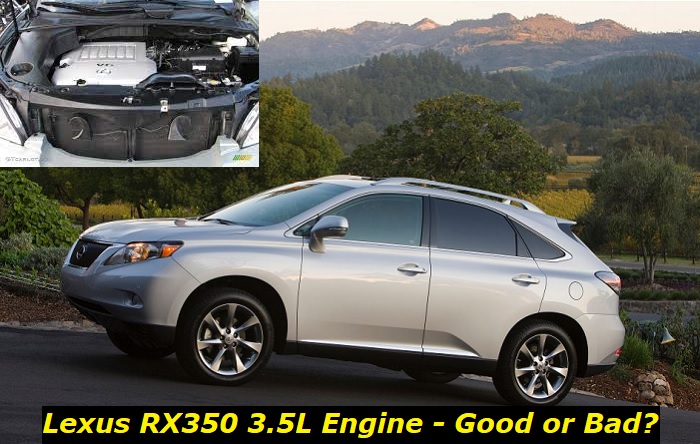Lexus takes all the things that make Toyota vehicles a hot commodity, particularly in terms of quality and utility, and elevates their character and prestige to consequently create a huge demand for them in the premium vehicle segment of the market.
The RX SUV, which stands for "Radiant Crossover", delivers what its name promises. It shines with its luxurious detailing in and out plus more tech, safety, and comfort elements. The performance and reliability, on the other hand, are taken care of by the application of the 3.5L engine (2GR-FE) in it.

Key features and my opinion about the engine
- Production years:2004-2018
- Average lifespan of 2GR-FE:220,000-260,000 miles
- Fuel supply type:port injection
- Power range:250-280 hp
- Fuel efficiency:bad
- Engine block material:aluminum
- Engine reliability score:high
- The most common problems:VVTi phasers are not the best ones, throttle contamination, uneven idling RPM, fast ignition coils wear.
Key Specifications of the 2008-2012 Lexus RX 3.5L Engine 2GR-FE
The 2GR-FE is considered to be the most popular version of the Toyota GR series of engines. Aside from the Lexus RX, it is also known for powering Toyota and Lotus models from 2005 all the way to the present. It should be noted though that it is in any way not related to the maker's GR (Gazoo Racing) performance division.
One thing that makes the 2008-2012 Lexus RX 3.5L Engine 2GR-FE well-known in the market as well as the tuning and engine swap scenes is its reliability and durability. It only has a few known issues, which we will discuss with you later on, and as long as they are addressed immediately, they are easy to fix and they don't put too much dent in your budget.
The 2GR-FE is a four-stroke, naturally aspirated engine with transverse mounting. It features an aluminum block and head for weight reduction and rigidity to withstand the high temperatures generated by the engine components.
The unit utilizes a dual-overhead camshaft with four valves per cylinder to allow the engine to breathe better at high speeds, which, in turn, translates to better power delivery. Moreover, this kind of design makes way for the placement of spark plugs in the middle of the combustion chamber in order to supplement combustion and enhanced ways to prime the engine.
A sequential fuel injection (SFI) is integrated into the engine to permit the firing of each injector individually. The setup is considered to be more efficient than the multiport system because it gives way to the rapid transformation of the fuel mixture into energy for fuel efficiency. Likewise, it is expected to produce less emission than other alternatives due to the more effective combustion it promotes.
Crunching the engine by its vital numbers, the 2GR-FE has a displacement of 3,456 cc, a bore measuring 94 mm, a stroke of 83 mm, and a high compression ratio of 11.8:1. The optimization of mechanical energy extraction from the combustion process results in an output of 270 hp at 6,200 rpm and 248 lb-ft of torque at 4,700 rpm for the 2008-2012 Lexus RX. With some tweaks, it could even reach 360 hp and 498 lb-ft. Despite the high outputs delivered by the engine, Lexus managed to keep its fuel economy at 18 mpg for city drives and 24 mpg on highway cruises for a combined range of 20 mpg.
The 2GR-FE is partnered with a six-speed automatic transmission with manual shifting, which in turn distributes its power to the all-wheel-drive system of the Lexus RX. The setup helps propel the luxury SUV from 0 to 60 mph in an estimated time of 7.25 seconds.
Longevity of the 2008-2012 Lexus RX 3.5L Engine 2GR-FE
It's safe to say that a properly maintained 2GR-FE can take you over 200,000 miles scot-free from major engine repairs or replacement. There are even many accounts that the power unit can go beyond that, proving its durability.
Like any other engine though, there are certain issues with the engine that most owners suffer from, which you should always keep a lookout for to maintain its integrity. However, this is a highly-resilient powerplant overall.
Most Common Causes of Troubles in the 2008-2012 Lexus RX 3.5L Engine 2GR-FE
Despite being synonymous with dependability, a significant number of 2GR-FE engines equipped in the 2008-2012 Lexus RX were affected by the following:
1. Oil Leaks
Oil leaks can have a few different causes. It could be something as simple as a loose oil filter or it could be something more serious like a cracked engine block. In the case of the RX prior to the 2010 update, it usually came from the rubber hose used by the VVT-i system. This hose would degrade over time and cause oil to leak. The good news is that this is an easy fix and only requires a new hose to be installed.
If you're unsure of what's causing your oil leak, the best way to test for it is to put a piece of cardboard under your car overnight. In the morning, check the cardboard for any signs of oil. If there is oil present, then you'll know you have a leak.
Once you've diagnosed the problem, it's time to start thinking about solutions. If it's something simple like a loose oil filter, then all you need to do is tighten it up and you should be good to go. For damaged hoses, a replacement will surely do the trick. However, if it's something more serious like a cracked engine block, then you'll need to take your car to a mechanic or dealership to get it fixed. In more ways than one, cylinder cracks may require an engine rebuild since these problems can easily compromise the other moving parts of your engine.
No matter what the cause of your oil leak is, it's important to get it fixed as soon as possible. Oil leaks can lead to serious engine damage if left unchecked.
2. Idler Pulley Fault
An idler pulley is a small wheel that helps route the engine's drive belts or chain. The pulley is usually located at the front of the engine, near the crankshaft. The idler pulley contains a bearing that allows it to rotate smoothly.
Over time, the idler pulley can develop problems that cause it to fail. The most common problem is wear and tear on the bearing. This can cause the pulley to make noise or even seize up completely.
The easily noticeable signs of idler pulley failure include excessive noise coming from the front of the engine, visible damage or wear, and loose or damaged drive belts. If the idler pulley fails, it can cause the RX 3.5L engine's drive chain to come off. This can lead to engine damage or a complete loss of power.
To avoid this, it's important to regularly check the condition of the idler pulley and replace it if necessary. Furthermore, since this issue likely results in the quick wear of the drive chain, you might as well replace it for a good measure if there are obvious signs of damage.
3. Water Pump Failure
Water pumps are one of the most important components in any vehicle's cooling system. The water pump circulates coolant through the engine to keep it operating at its optimal temperature. A failed water pump can cause the engine to overheat, which can lead to serious damage.
There are several visual signs that indicate a water pump is failing. These include leaks from the pump itself, as well as from the hoses and connections leading to and from the pump. Another sign of failure is an unusual noise coming from the pump while the engine is running. If you notice any of these signs, it's important to have your vehicle checked by a qualified technician as soon as possible.
There are several possible causes of water pump failure. One is a loss of coolant due to a leak in the system. This can cause the pump to run dry and overheat, which can damage the pump's bearings. Another common cause is debris getting lodged in the pump, which can prevent it from turning properly. This can also lead to overheating and damage.
If your water pump has failed, it will need to be replaced. In some cases, it may be possible to clean or repair the pump, but in most cases, it will need to be replaced completely. Be sure to have your vehicle checked by a qualified technician as soon as you notice any signs of water pump failure.
One of the main causes of many Lexus RX 3.5L engine damage prior to the 2010 update came from this particular problem.
Is the 2008-2012 Lexus RX 3.5L Engine 2GR-FE Worth It?
Based on the facts stated here and public consensus, the 2008-2012 Lexus RX 3.5L Engine 2GR-FE is definitely worth your money. With proper maintenance and care, this is one of the Toyota or Lexus engines that could withstand over 200,000 miles of use.
About the authors
The CarAraC research team is composed of seasoned auto mechanics and automotive industry professionals, including individuals with advanced degrees and certifications in their field. Our team members boast prestigious credentials, reflecting their extensive knowledge and skills. These qualifications include: IMI: Institute of the Motor Industry, ASE-Certified Master Automobile Technicians; Coventry University, Graduate of MA in Automotive Journalism; Politecnico di Torino, Italy, MS Automotive Engineering; Ss. Cyril and Methodius University in Skopje, Mechanical University in Skopje; TOC Automotive College; DHA Suffa University, Department of Mechanical Engineering






Add comment